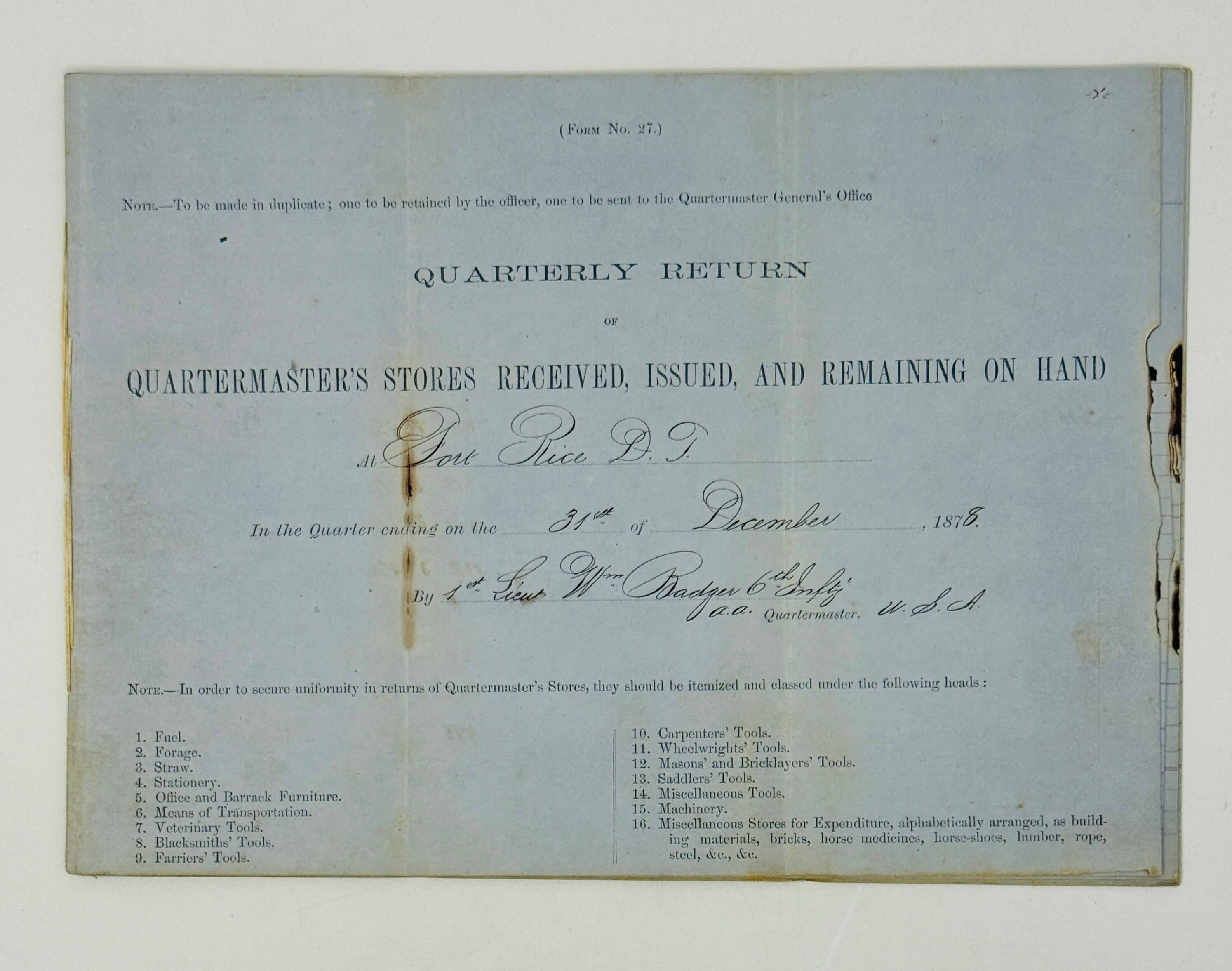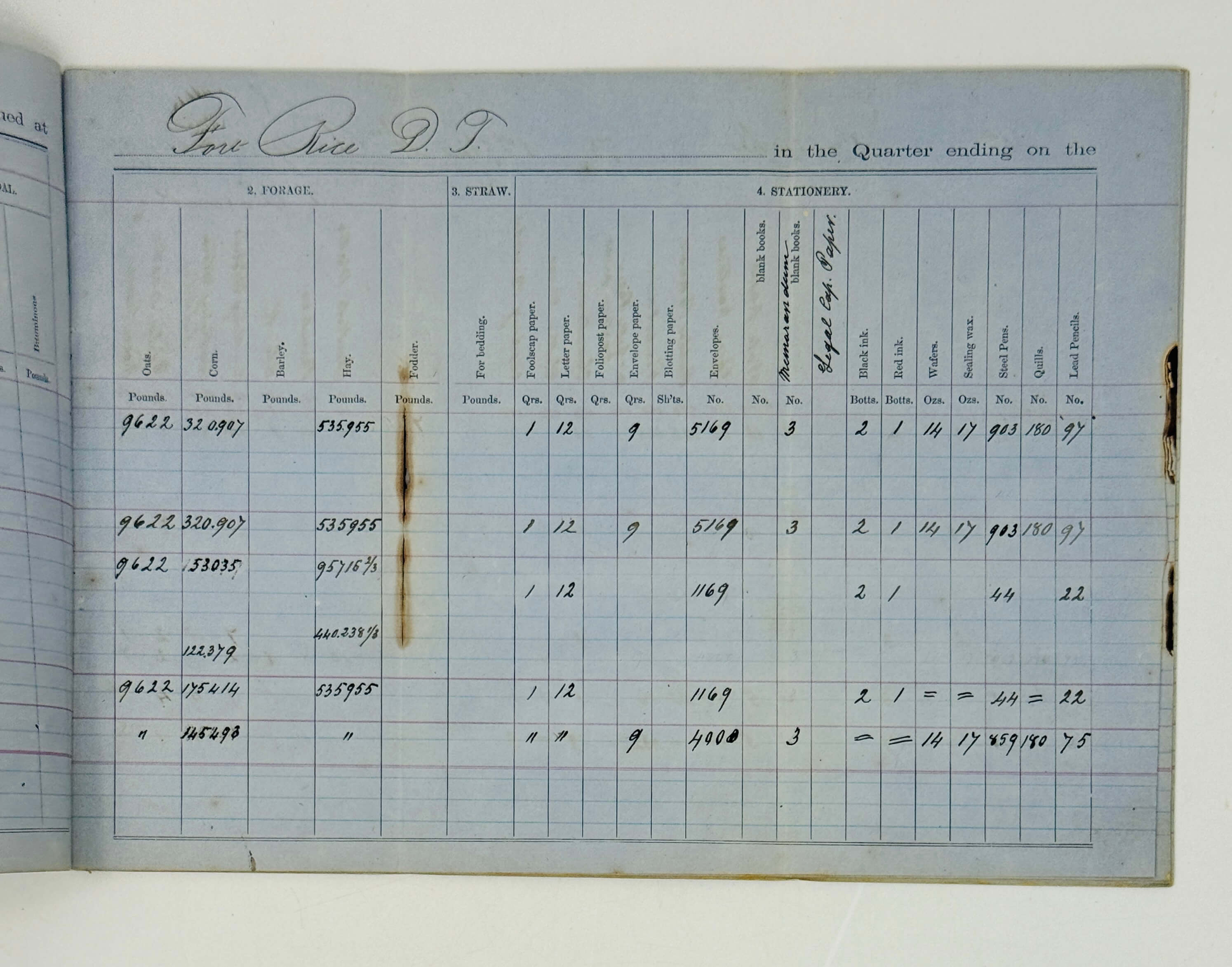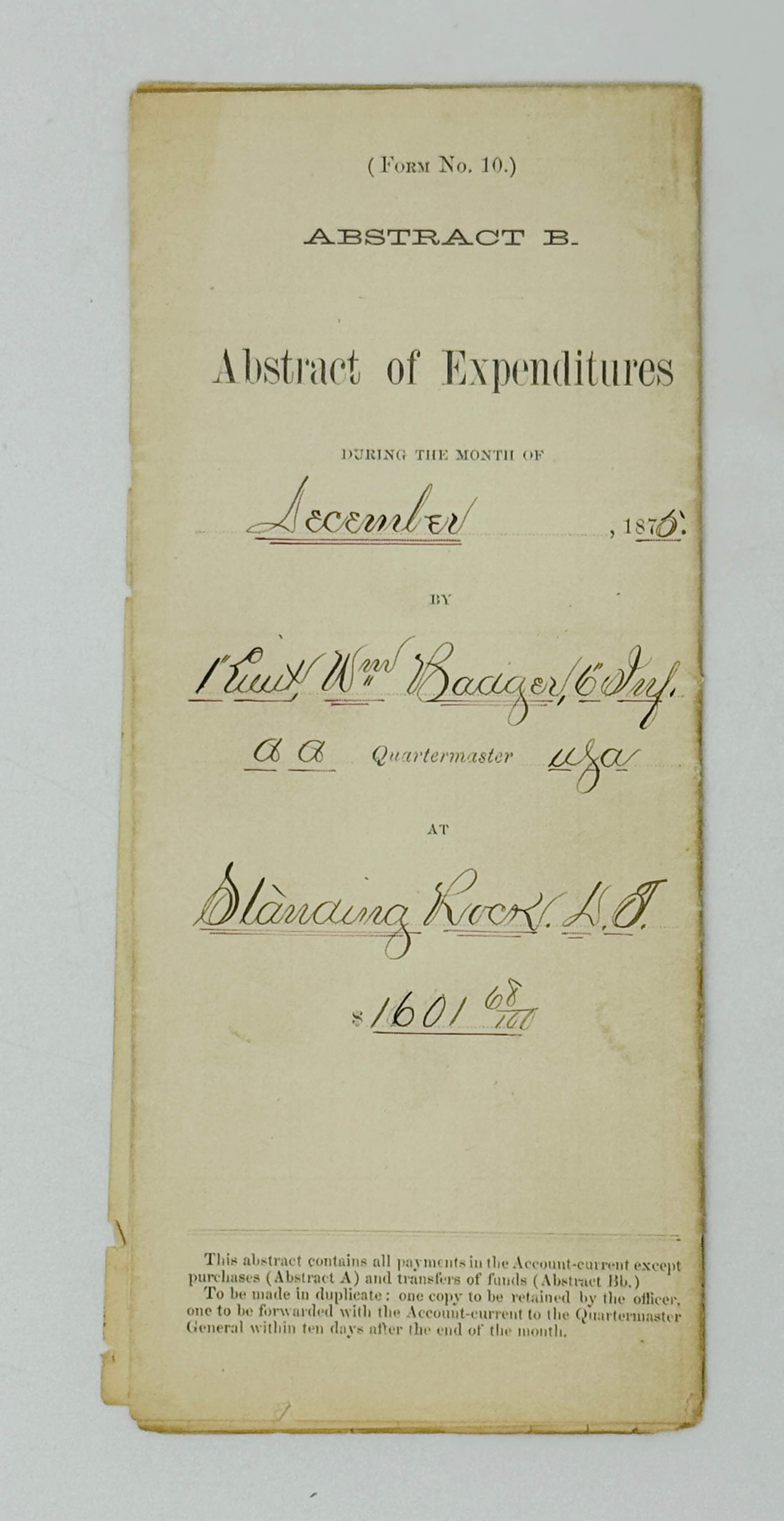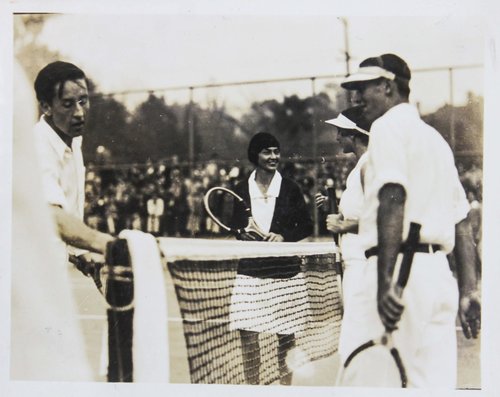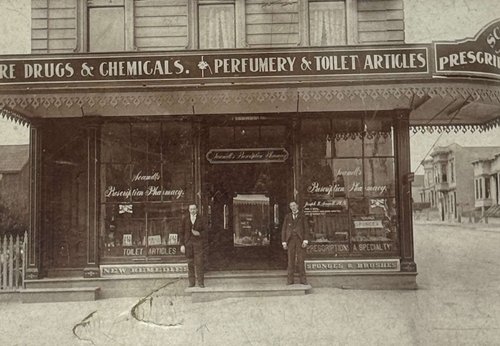
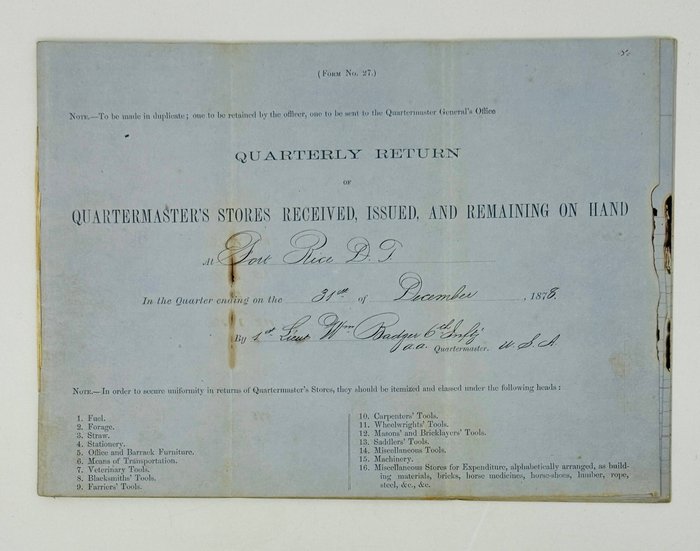
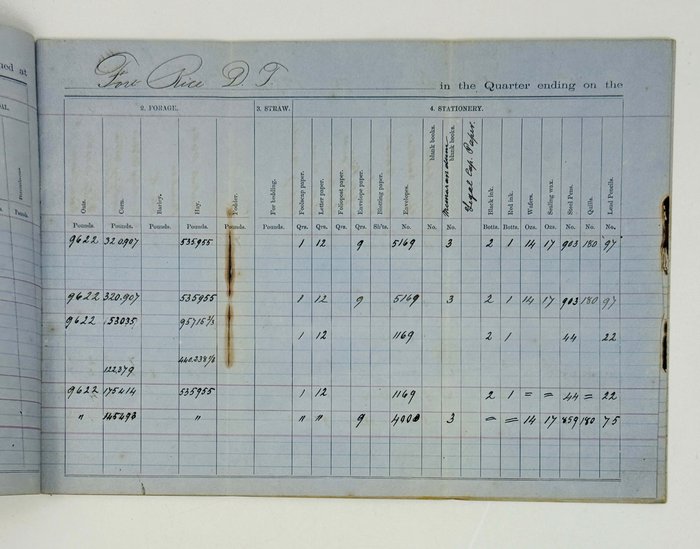
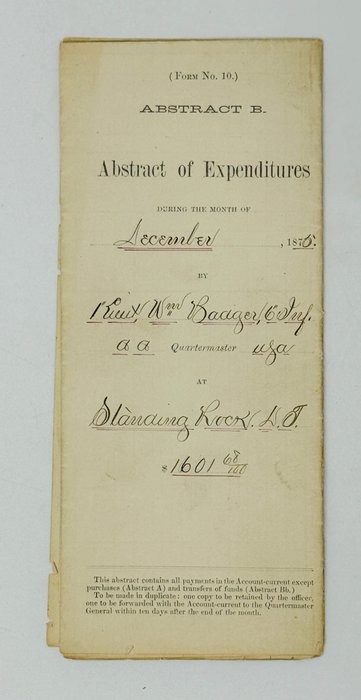
#MA46
1875, 1878
Folio bifolium (ca. 37,5x22 cm or 14 ½ x 8 ½ in). 3 pp. Printed form completed in manuscript. Brown ink on creamy lined wove paper; several titles underscored in red. Foldmarks, several minor holes on folds, several minor tears on extremities, but overall a very good document written in a legible hand.
Fort Rice, D.[akota] T.[erritory], 31 December 1878. Oblong Folio (ca. 20x27,5 cm or 7 ¾ x 10 ¾ in). 14 leaves fastened with a thread (2 blank). [T.p.], [10], [1] pp. Printed form completed in manuscript. Brown ink on blueish lined wove paper; several titles underscored in red. Foldmarks, all leaves with long narrow holes (apparently caused by fire) on one of the folds (affecting the text on at least six leaves), minor losses on the blank margins of the first four leaves (not affecting the text), otherwise a very good document written in a legible hand.
Historically significant collection of two original documents, recording the expenses for personnel and supplies in the U.S. Army’s stations in the Dakota Territory - Standing Rock Cantonment (since 1878 – Fort Yates) and Fort Rice (on the Upper Missouri River south of Mandan, Morton Co.) – shortly before and after the Great Sioux (Black Hills) War of 1876. Both documents were compiled and signed by a U.S. Army career officer and Civil War veteran, Lieutenant William Badger. A son of William Badger Sr., the Governor of New Hampshire in 1834-36, he graduated from Dartmouth College in 1848 and worked with several New Hampshire companies (Union Manufacturing Co. in Gilmanton, Tilton Manufacturing Co. in Tilton, &c.). During the American Civil War, he served in the 4th and later the 9th New Hampshire Volunteer Regiments. In 1866, Badger Jr. was commissioned as a lieutenant in the 6th U.S. Infantry and served with them until his retirement in 1889 (See: Babcock, E. A War History of the Sixth U.S. Infantry from 1798 to 1903… Kansas City, 1903, pp. 107, 115, 129). During the height of the Sioux Wars in the 1870s, Badger served as a quartermaster in several U.S. military posts in the Dakota Territory, including Fort Buford and Fort Abraham Lincoln – in the latter when Lt.-Col. George Armstrong Custer’s (1839-1876) 7th Cavalry Regiment was stationed there preceding the Battle of the Little Bighorn (Fort Life in ‘70’s Recalled// The Fargo Forum. Fargo, N.D., 28 July 1929, p. 9). William Badger and Custer were acquainted, and the former’s son, William Cogswell Badger (1857-1897), then a 19-year-old man, “accompanied Lieut. Col. George A. Custer on his expedition into the Black Hills to discover the truth of the rumor of fabulous amounts of gold in the summer of 1874” (William C. Badger, Pioneer N.D. Man, is Dead at Toledo// The Bismarck Tribune, January 20, 1937, p. 2). In the 1880s, William Badger served in Fort Leavenworth, Kansas (See more about his biography in: Jameson, E.O. The Cogswells in America. Boston, 184, pp. 207-208; see more).
The earlier document was compiled in the Standing Rock Cantonment of the U.S. Army, which was renamed Fort Yates in 1878 and is now the headquarters of the federally recognized Standing Rock Sioux Tribe. The “Abstract of Expenditures at the Standing Rock Cantonment” is dated December 1875, about half a year before the Battle of the Little Bighorn which resulted in an overwhelming defeat of the U.S. forces and the death of George Custer. The document lists the vouchers paid to “Citizen Employees,” an “Interpreter” and for “Extra Duty Mess” for the total amount of $1601,68.
The second document is a 10-page “Quarterly Return of Quartermaster’s Stores Received, Issued and Remaining on Hand at Fort Rice in the Quarter ending on the 31st of December, 1878.” Badger records the movement of supplies in over a dozen categories: fuel (soft wood), forage (oats, corn, hay), stationery (various paper, envelopes, ink, wax, pens, quills, pencils, office tape, erasers, paper folders, rubber bands, sandboxes, letter press & many others), barrack & office furniture (clock, cooking and heating stoves, field desks, iron safe, ice box, lockers, pans for frying and baking, tables, tea kettles, &c.), means of transportation (ambulances, army wagons, blankets saddle, brooms, a “ferry boat,” horses, mules, jockey sticks, “yawl boat,” “bob sledges,” &c.); veterinary, blacksmiths,’ carpenters,’ masons’ and bricklayers,’ saddlers’ tools, miscellaneous tools (brass sundial, hay forks and scales, lifting jack, paint brushes, rubber fire buckets, scythes, wood saws, &c.), machinery (belting assistant, circular saws, gumming machines), horse medicines, and “stores for expenditure” (bolts, bridle leather, cotton twine, harness rings, horse shoes, nails, nuts, oars, rope, rivets, tar coal, wax black & many others).
Overall an important collection of original documents providing a compelling insight into the everyday life of the U.S. military posts in the Dakota Territory shortly before and after the Great Sioux War of 1876. An archive of original William Badger’s documents, created during his service as a quartermaster in the 6th Infantry in the Dakota Territory, is deposited in the special collections of the State Historical Society of North Dakota (see more).

